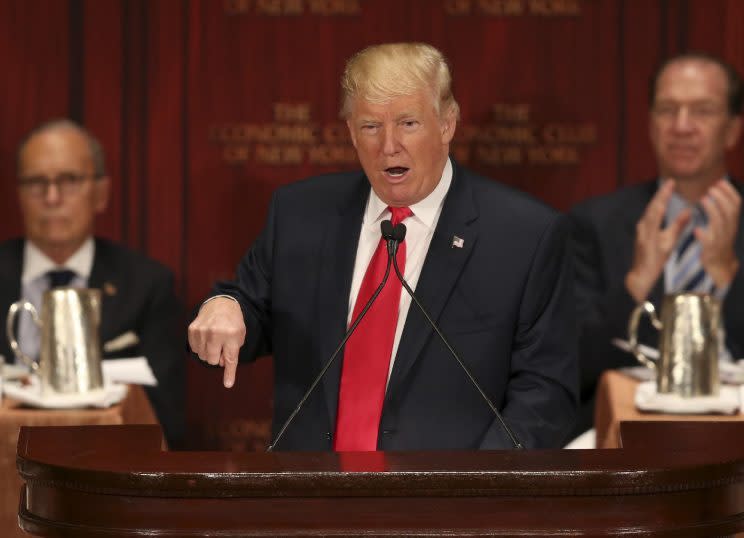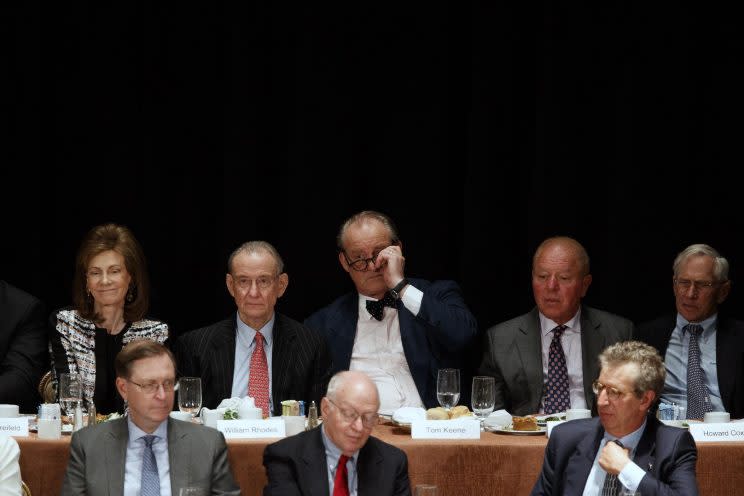‘I brought some notes’: Trump delivers economic policy speech in latest rebranding effort
NEW YORK — Seeking to bolster his policy bona fides, Donald Trump presented more details about his economic plan during a Thursday speech here, suggesting his policies will spur historic growth that would not only cut the federal debt but pay for both the large tax cuts and new federal spending he’s proposing.
Trump told the Economic Club of New York that he would set the U.S. economic growth goal at 4 percent annually — or roughly double the annual rate the U.S. has experienced in recent decades. And, going off script, the Republican presidential nominee suggested his proposed mix of tax cuts, curbs to federal regulations and plan to renegotiate trade deals might help the economy surge even higher.
“My great economists don’t want me to say this, but I think we can do better than that,” Trump said of the 4 percent growth goal.
That growth target echoed the one previously offered by former Florida Gov. Jeb Bush, one of Trump’s vanquished primary rivals who also launched his White House bid with a pledge of 4 percent growth. At the time, critics argued that the president doesn’t have enough sway over the economy to keep such a promise.
During his Thursday speech, Trump echoed many of the policies he presented at a major economic speech last month in Detroit. The celebrity businessman turned political candidate said a new focus on “Americanism” over policies that promote globalism would be the driving factor behind growth under his presidency, which he estimated would create 23 million new jobs over the next decade.

Among other things, Trump cited the cost savings of asking foreign allies like Germany, Japan and Saudi Arabia to pay for their own security, breaking away from years of international alliances. He said that money could be used to rebuild decaying American infrastructure. And repeating a regular line of his stump speech, Trump said he would either renegotiate trade deals like NAFTA and the Trans-Pacific Partnership or exit the agreements altogether.
“Everything that is broken today can be fixed, and every failure can be turned into a great success,” Trump said. “Jobs can stop leaving our country and start pouring in. Failing schools can become flourishing schools. Crumbling roads and bridges can become gleaming new infrastructure. Inner cities can experience a flood of new jobs and investment. And rising crime can give way to safe and prosperous communities.”
“All of these things, and so much more, are possible,” he added. “But to accomplish them, we must replace the present policy of globalism — which has moved so many jobs and so much wealth out of our country — and replace it with a new policy of Americanism.”
At the same time, Trump trashed his Democratic rival Hillary Clinton, painting her economic proposals as based around “tired’ and “failed” ideas.

“In Hillary Clinton’s America, we have surrendered our status as the world’s great economy, and we have surrendered our middle class to the whims of foreign countries,” Trump insisted. “Not one single idea she has will create one net American job, or create one new dollar of American wealth for our workers. The only thing she can ever offer is a welfare check.”
Trump also said he would cut nondefense spending, though he said he would exclude entitlement programs, which are expected to be the leading driver of federal spending over the next few decades. Trump has regularly promised to make sure Americans get their Social Security checks, but he has not offered many details of how he would protect entitlement plans or pay for them.
Indeed, Trump has remained vague about how exactly he would pay for his economic proposals, which include a proposed $4 trillion tax cut as well as a new childcare plan he unveiled earlier this week. At one point he instructed the audience, which was made up of some of New York’s top finance and corporate leaders, to simply go to his campaign website and read the plan for themselves. “Just look at the math,” the GOP nominee claimed. “It works.”
The speech came as Trump has tried to recast his campaign as a softer, more policy-oriented endeavor in recent weeks as he attempts to win over voters skeptical of his reputation as a loose cannon.

Over the last month, the GOP nominee has shown a new dedication to staying on message — relying on the teleprompter, a device he used to mock his rivals for using — at nearly every public appearance. But on Thursday, technical difficulties nearly derailed Trump’s speech when his teleprompter didn’t display when he took the stage.
The candidate awkwardly tried to kill time, making small talk about improving polls as he waited for the machine to come to life.
“It’s always a lot of fun when you come up and the people don’t have the teleprompter working, but that’s OK,” he finally said, an edge of irritation in his voice. “Luckily, I brought some notes.”
A few minutes later, after he stiffly read from those notes, the machine began to work — which inspired Trump to pause and boast to the audience that he had “seamlessly” transitioned from his notes to the words on the screen. But he was still irked by the bumpy beginning.
As he sat down for a question-and-answer session with a supporter after his remarks, Trump noticed a worker coming to remove the machine from the stage and asked what had happened. Turning to the audience, the GOP nominee announced, “He’s a little late, right?”



